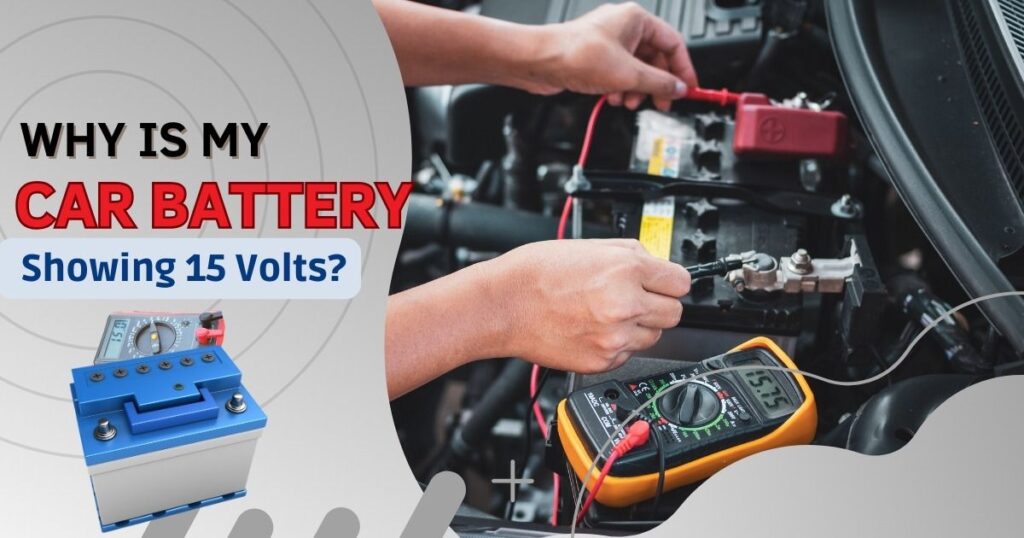Why is My Car Battery Showing 15 Volts and Does it Matter?
Have you ever been in a situation where you start your car, glance at the dashboard, and notice your battery voltage is unexpectedly reading 15 volts? This scenario is common, and can leave even seasoned car owners scratching their heads.
Usually, a good battery has a voltage or power level of between 12.6 to 12.8 volts. When the voltage exceeds the range, it could be a sign of something wrong with the charging system or other electrical components in the vehicle. In this article, we’ll discuss some of the reasons why your 12-volt battery might be behaving a bit unexpectedly and how to address the situation.
Normal Operating Voltage Range
A car battery’s performance is closely tied to its voltage rating. As we have stated, a healthy, fully charged car battery typically registers a voltage between 12.6 to 12.8 volts. This range reflects the battery’s ability to store and deliver electrical energy effectively.
However, it’s important to note that voltage readings can vary based on external factors. For instance, car batteries may exhibit a slightly lower voltage in colder climates, while higher temperatures can lead to a temporary increase. Additionally, factors like frequent short trips or heavy electrical usage can impact voltage readings.
Despite these variations, maintaining the battery within the specified normal operating voltage range is crucial for optimal performance and longevity. Deviations from this range can impact the battery’s ability to start the vehicle, power electrical components, and overall reliability.

Why is my Car Battery Showing 15 Volts?
A car battery reading 15 volts on the voltage meter can raise concerns, and it often points to underlying issues in the vehicle’s charging system. These issues can range from a minor overcharging problem, to serious multiple system failures. That said, here are the most common reason why your car battery may show 15 volts;
Voltage Regulator Failure
The voltage regulator plays a critical role in the vehicle’s charging system by ensuring a stable voltage output from the alternator. If the voltage regulator fails, it can lead to overcharging, making the voltage rise beyond the normal range. This can result in damage to the battery and other electrical components, which might impact the overall performance of the vehicle.
Faulty Alternator
The alternator is responsible for charging the battery. If the alternator is faulty, it can fail to regulate the charging properly, leading to elevated voltage levels. The excess voltage can, in turn, damage the battery and other electrical components. If you observe a consistent 15-volts voltage reading, it’s recommended to counter-check the condition of the alternator.
Battery Issues
A faulty battery can also cause abnormal voltage readings. This might be due to a short circuit or other internal problems within the battery. These issues often disrupt the normal flow of electrical energy, leading to irregular voltage levels, including 15 volts or higher on the voltage meter.
Grounding Problems
A vehicle’s electrical system relies on proper grounding to ensure the flow of current and maintain stable voltage levels. Grounding problems in a vehicle can cause erratic voltage readings, including readings that may appear unusually high, such as 15 volts or more.
If there is a poor or faulty ground connection, it can lead to voltage irregularities. In some cases, a poor ground can cause the voltage regulator to malfunction, resulting in overcharging of the battery. This overcharging can then lead to elevated voltage readings.
Faulty Voltage Meter
At times, when confronted with irregular voltage readings, it’s essential to consider the possibility of a faulty voltage meter. A defective voltage meter can lead to inaccurate readings due to internal malfunctions, calibration issues, or general wear and tear. Ruling out issues with the meter is a crucial step in diagnosing and addressing high or incorrect voltage readings.
Wiring Problems
The wiring in a car plays a crucial role in facilitating the flow of electrical current between various components, including the battery, alternator, and other electrical devices. If there are issues with the wiring, such as damaged or corroded wires, poor connections, or short circuits, it can disrupt the normal flow of current and impact the accuracy of voltage measurements. For instance, resistance in the wiring can cause voltage fluctuations, leading to inaccurate readings on the voltage gauge.
Aftermarket Modifications
If there have been aftermarket modifications to the vehicle’s electrical system, they could be a source of the problem. For instance, using non-standard components or alterations can interfere with the established electrical configuration. This interference is bound to affect the normal operation of the charging system, voltage regulation, and other crucial components. As a result, irregular voltage readings may occur, deviating from the expected ranges.
Engine RPM Issues
The car battery voltage output is intricately linked to the engine’s RPM. In situations where there are fluctuations or irregularities with the engine speed, it can have a direct impact on the alternator’s performance and, consequently, variations in the voltage output.
Consequences of High Voltage
Generally, car batteries are designed to operate within a specific voltage range, typically around 12 volts. If you exceed this voltage range, it can lead to several issues including;
Overcharging the Battery
If the charging voltage from the alternator or external charger is too high, it can lead to overcharging problem. Overcharging can cause the electrolyte in the battery to heat up excessively, leading to the release of gas and potentially damaging the battery.
Electrical Component Damage
The electrical components in a car, such as the alternator, starter, lights, and electronic control units, are designed to operate within specific voltage limits. Excessive voltage can damage these components, leading to malfunction or system failure.
Bulb and Fuse Damage
Higher voltage can cause bulbs to burn out prematurely and may also blow fuses. The increased voltage often puts additional stress on the filaments in bulbs and the conductive elements in fuses, leading to failure.
Electronic System Failure
Modern vehicles rely heavily on electronic systems for various functions, including engine control, emissions control, and entertainment systems. High voltage can disrupt the operation of these systems, leading to malfunctions or even permanent damage.
Potential Fire Hazard
In extreme cases, excessively high voltage can cause electrical wiring to overheat, leading to a fire hazard. This is a serious risk that can pose a significant threat to the vehicle and its occupants.
Accelerated Battery Aging
A sustained voltage level of 15 volts or higher can potentially cause damage to a car battery over time. Continuous exposure to elevated voltage levels can shorten the overall lifespan of the battery, leading to the need for premature replacement. It can also cause irreversible damage to the battery cells and reduce its capacity to hold a charge.
Reduced Battery Performance
Prolonged exposure to high voltage levels can diminish the battery’s ability to deliver consistent power. Reduced battery performance can result in difficulties starting the vehicle and unreliable operation of electrical accessories.
How to Prevent High Car Battery Voltage
- Measure the battery voltage periodically with a multimeter, especially if you notice any electrical issues. This can help you identify problems early on and prevent damage to other components.
- Regularly inspect the battery for signs of damage, corrosion, or leaks. Ensure the battery terminals are clean and securely connected. Consider replacing the battery if it shows signs of deterioration.
- Check the output voltage to ensure it falls within the manufacturer’s specified range. If the voltage is consistently too high, ensure you get to the root cause of the issue.
- Periodically perform load tests on the battery to assess its health. This helps identify potential issues before they lead to electrical system problems.
- Apply battery terminal grease or anti-corrosion spray to the battery terminals to prevent corrosion. Clean any existing corrosion as soon as possible.
- Inspect the wiring and connections in the charging system regularly. Look for loose or damaged wires, and address any issues immediately to prevent voltage irregularities.
- When jump-starting a vehicle, ensure that the jumper cables are connected correctly, with the positive (+) and negative (-) terminals matched. Incorrect connections can lead to voltage spikes and damage electronic components.
- As mentioned, extreme temperatures can affect battery performance. In hot climates, keep the battery cool, and ensure it has sufficient cranking power. Consider using a battery insulator or heater in extreme conditions.
- Be mindful of aftermarket electrical accessories or modifications. Ensure they are installed correctly and do not draw excessive power from the electrical system.
- When replacing batteries, alternators, or other electrical components, choose high-quality, compatible parts. Using substandard components can lead to premature failure and voltage irregularities.
Is 15 Volts Too High for Car Battery?
A car battery’s voltage should be around 12.6 volts when fully charged. While the voltage can vary slightly depending on the type of battery and the specific conditions, a voltage of 15 volts is too high than what is typically considered normal for a fully charged car battery.
If your car’s charging system is consistently producing a voltage of 15 volts or higher, it could indicate a problem with the battery or charging system. Ideally, continuous exposure to high voltage levels can damage the battery and other sensitive components. As such, it is always a good idea to address the problem to prevent further damage and ensure the proper functioning of your car’s battery.
Also Read: Why is My Rear View Mirror Blue? Here is The Truth!
The Parting Shot!
The vehicle’s battery provides the essential power for its functionality and various features. The battery is responsible for not only starting the engine but also enabling functions such as window operation, door locking, and music playback. So, when something like a voltage reading of 15 volts pops up, it’s just natural to get worried. Luckily, timely intervention can help maintain the overall health of your battery and ensure smooth operation.







